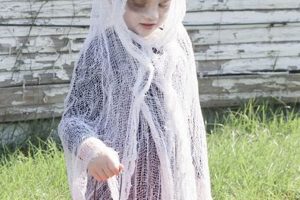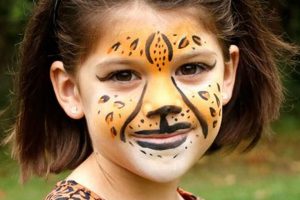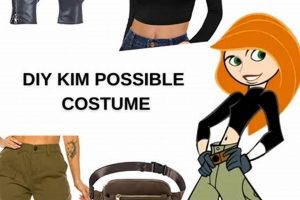Creating attire resembling the animated character, SpongeBob SquarePants, through do-it-yourself methods represents a popular crafting activity. Such projects involve utilizing readily available materials and individual creativity to replicate the character’s distinctive features. An example is constructing a rectangular body from cardboard, painting it yellow, and adding details like holes and a tie.
This endeavor offers several advantages, including cost-effectiveness and personalization. It provides an opportunity to engage in artistic expression and resourcefulness, resulting in a unique outfit distinct from mass-produced alternatives. Historically, homemade versions of character-based clothing have provided accessibility and creativity, especially when commercially available options are limited or expensive.
The subsequent sections will explore specific methods for constructing such an outfit, detailing required materials, step-by-step instructions, and considerations for achieving a recognizable and durable finished product.
Tips for SpongeBob SquarePants-Inspired Homemade Attire
The creation of a visually accurate and structurally sound SpongeBob SquarePants-themed outfit necessitates careful planning and execution. The following guidelines offer practical advice to ensure a successful outcome.
Tip 1: Material Selection: Opt for sturdy yet lightweight materials for the primary structure. Cardboard, foam board, or even fabric stretched over a frame provide a stable base without excessive weight, enhancing wearer comfort.
Tip 2: Dimensional Accuracy: Pay close attention to the character’s proportions. A rectangular body with a height slightly exceeding its width generally provides a visually accurate representation. Measure carefully and double-check dimensions before cutting materials.
Tip 3: Hole Placement and Size: SpongeBobs characteristic holes should be rendered realistically. Vary the size and placement of the holes to avoid a uniform, unnatural appearance. Consider using stencils or templates to ensure consistent shapes.
Tip 4: Color Consistency: Aim for a consistent and vibrant yellow hue for the main body. Multiple coats of paint or dye may be necessary to achieve a solid and opaque finish. Ensure the chosen paint is compatible with the base material.
Tip 5: Feature Detailing: The tie, eyes, and mouth require precise detailing. Use high-quality acrylic paints or durable felt to create these features. Consider using dimensional fabric paint to add texture and depth.
Tip 6: Structural Reinforcement: Reinforce corners and edges with strong adhesive or fabric tape to prevent premature wear and tear. This is especially critical if the costume will be worn for extended periods or during active events.
Tip 7: Wearer Comfort: Incorporate features that enhance comfort, such as padded shoulder straps or breathable lining. This can significantly improve the overall experience and prevent overheating.
Adherence to these recommendations will contribute to the creation of a visually appealing and structurally sound outfit. Careful attention to detail and a commitment to quality materials are paramount to achieving a satisfactory result.
The next section will address specific challenges encountered during the construction process and propose potential solutions.
1. Material Selection
Material selection is a foundational element in the creation of do-it-yourself attire inspired by the animated character SpongeBob SquarePants. The chosen materials directly influence the costume’s appearance, durability, comfort, and overall feasibility.
- Rigidity and Shape Retention
The primary material must maintain a rectangular form characteristic of the character. Options include cardboard, foam board, and fabric stretched over a frame. Cardboard offers affordability but may lack structural integrity, while foam board provides enhanced rigidity. Fabric offers flexibility but necessitates a supporting structure. The selection impacts the costume’s ability to retain its shape throughout wear.
- Paint Compatibility
The selected material must be compatible with paint or dye. Smooth surfaces generally facilitate even color application, while porous surfaces may require priming or multiple coats. Incompatible materials can lead to paint peeling, cracking, or uneven coloration, compromising the costume’s visual fidelity. For example, some plastics may require specialized paints for proper adhesion.
- Weight and Comfort
The weight of the selected material influences wearer comfort, especially during extended use. Lightweight materials such as thin foam or fabric are preferable to heavy alternatives like thick cardboard. Excessive weight can cause fatigue and discomfort, deterring the wearer from fully enjoying the costume. Padding and breathable linings can further enhance comfort regardless of the primary material’s weight.
- Durability and Longevity
The material’s inherent durability determines the costume’s lifespan. Materials prone to tearing, crushing, or water damage may require reinforcement or protective coatings. Fabrics can be reinforced with interfacing, while cardboard can be strengthened with tape or resin. Durability is crucial for costumes intended for repeated use or outdoor events.
Therefore, careful consideration of rigidity, paint compatibility, weight, and durability is essential for effective material selection in the creation of SpongeBob SquarePants-themed attire. The chosen materials directly impact the costume’s appearance, comfort, and longevity, ultimately determining its success as a do-it-yourself project.
2. Structural Design
The structural design of a homemade SpongeBob SquarePants outfit is paramount to its recognizability and functionality. The character’s iconic rectangular shape presents a specific engineering challenge: how to translate a two-dimensional cartoon character into a wearable, three-dimensional form. Poor structural design leads to a costume that is misshapen, unstable, and uncomfortable, thus failing to effectively represent the character. A structurally sound design, conversely, maintains the desired form, withstands movement, and allows for comfortable wear. For example, a frame built from PVC pipes or sturdy cardboard provides the necessary support to maintain the rectangular shape, preventing it from collapsing under its own weight or during movement.
A critical element of structural design includes considerations for weight distribution and wearability. Even with lightweight materials, improper weight distribution can cause the costume to pull unevenly, leading to discomfort and instability. Shoulder straps or internal harnesses are commonly employed to distribute the wei
ght evenly across the wearer’s shoulders and back. Furthermore, the design must accommodate the wearer’s range of motion. Hinged panels or flexible materials at the joints can allow for easier movement of the arms and legs. One can observe these design considerations in commercially available mascot costumes, where internal structures and support systems are crucial for both appearance and performance.
In summary, structural design is an indispensable component in the successful creation of SpongeBob SquarePants-inspired attire. A well-executed design addresses challenges related to shape maintenance, weight distribution, and wearability. While creative decoration and accurate color replication are important, a flawed underlying structure will ultimately undermine the entire project. Therefore, careful planning and execution of the structural design phase are essential for achieving a visually appealing and functional result.
3. Color Fidelity
Color fidelity, the accuracy of color reproduction, is a key determinant in the success of a do-it-yourself SpongeBob SquarePants costume. The character’s vibrant and recognizable palette necessitates careful attention to replicating the original hues. Deviation from these colors diminishes the visual impact and recognizability of the costume.
- Yellow Consistency
The dominant color of SpongeBob SquarePants is a specific shade of yellow. Achieving a consistent and accurate yellow across all costume components, such as the body, sponges, and any fabric elements, is crucial. Inconsistent yellows create a disjointed and amateurish appearance. Paint or fabric dye should be matched to a reference image or color swatch to ensure uniformity.
- Feature Contrast
The character’s facial features, including the eyes, mouth, and buck teeth, rely on sharp color contrasts for definition. White for the eyes and teeth, combined with black outlines and a vibrant red for the tie, require precise execution. Blurring or bleeding of these colors can obscure the features and reduce their impact. The application of stencils or fine-tipped brushes aids in achieving the necessary precision.
- Hole Detailing
The porous texture of SpongeBob SquarePants is represented by a multitude of holes. The color of these holes, typically a darker shade or a contrasting color, contributes to the character’s distinctive appearance. Inaccurate hole coloration can flatten the visual texture and reduce the three-dimensionality of the costume. The depth and color of the holes can be emphasized through shading techniques or the use of darker colored material underneath.
- Material Color Interaction
The interaction between the chosen materials and the applied colors influences the final result. Certain materials may absorb paint or dye differently, leading to variations in color intensity. A preliminary test on a scrap piece of material is recommended to assess color absorption and adjust application techniques accordingly. This proactive approach minimizes unexpected color distortions and ensures a consistent visual outcome.
These elements of color fidelity directly influence the overall success of recreating SpongeBob SquarePants in a do-it-yourself costume. Accurate color reproduction and attention to contrast and detail are critical for achieving a recognizable and visually appealing result.
4. Feature Accuracy
Feature accuracy, the faithful replication of distinct physical attributes, holds significant importance in the successful creation of attire that mimics the animated character SpongeBob SquarePants through do-it-yourself methods. Accurate rendition of key characteristics is crucial for immediate recognition and overall aesthetic quality.
- Facial Feature Proportions
The character’s eyes, mouth, and teeth exhibit specific proportions relative to the overall face. The eyes, for instance, are disproportionately large and widely spaced. Accurate reproduction of these proportions is essential for maintaining the character’s recognizable appearance. Deviations result in a distorted and less convincing representation. This requires careful measurement and scaling during the construction process, ensuring that each facial element aligns with the established ratios.
- Hole Representation
SpongeBob SquarePants is characterized by numerous holes distributed across his body. The size, shape, and placement of these holes contribute significantly to his visual identity. Accurately recreating these details, rather than simply adding random perforations, requires meticulous attention. Using templates or stencils aids in achieving uniformity and consistency in hole size and distribution. The number of holes should also approximate the character’s standard depiction to enhance recognition.
- Appendage Replication
The character’s limbs, including arms, legs, and tie, are simplified yet distinctive. The tie, in particular, is a small but crucial element. Its size, shape, and color must be accurately replicated to maintain the character’s overall aesthetic. Similarly, the stubby nature of the arms and legs should be reflected in the costume’s design. Inaccurate appendage replication detracts from the costume’s overall authenticity.
- Textural Mimicry
While difficult to fully replicate, the textural representation of SpongeBob SquarePants adds depth to the design. Mimicking the porous nature of the character’s body can be achieved through various techniques, such as applying textured paint or using materials with inherent surface irregularities. This element of feature accuracy, while subtle, contributes significantly to the costume’s overall realism and visual appeal.
These facets of feature accuracy directly impact the visual fidelity of a SpongeBob SquarePants-inspired creation. Careful attention to facial proportions, hole representation, appendage replication, and textural mimicry elevates the costume from a generic yellow rectangle to a recognizable and engaging representation of the iconic character. The extent to which these features are accurately rendered directly correlates with the success of the do-it-yourself endeavor.
5. Durability Enhancement
Durability enhancement is a critical consideration in the construction of a SpongeBob SquarePants-themed do-it-yourself outfit. The longevity and wearability of such a costume are directly influenced by the implementation of techniques and materials designed to withstand stress, movement, and environmental factors. Without adequate reinforcement, the costume is susceptible to damage, reducing its lifespan and diminishing its aesthetic appeal.
- Edge Reinforcement
The edges of a cardboard or foam-based costume are particularly vulnerable to tearing and bending. Reinforcing these edges with durable tape, fabric edging, or even resin coatings significantly increases their resistance to damage. For example, applying multiple layers of duct tape to the corners of a rectangular cardboard body distributes stress more evenly, preve
nting sharp bends and potential tears. Similarly, fabric edging sewn along the perimeter of fabric-covered frames offers added protection against fraying and abrasion. This is especially critical if the costume will be worn in crowded or outdoor environments. - Structural Support
Internal bracing and support structures contribute significantly to the overall durability of the costume. These supports prevent the costume from collapsing under its own weight or from distorting during movement. Examples include PVC pipe frames within fabric costumes or strategically placed cardboard strips within a larger cardboard structure. Such supports distribute weight evenly and maintain the costume’s intended shape, minimizing stress on individual components. Internal supports are crucial for costumes designed for active events, such as parades or costume contests.
- Surface Protection
The surface of the costume, especially if painted or decorated with delicate materials, requires protection from abrasion, moisture, and sunlight. Applying a sealant or protective coating shields the surface from scratches, fading, and water damage. For instance, a clear acrylic sealant applied to a painted cardboard costume creates a barrier against moisture and UV rays, preserving the vibrancy of the colors. Similarly, a fabric spray protectant repels water and stains, extending the lifespan of fabric elements. Surface protection is particularly important for costumes intended for outdoor use or repeated wear.
- Fastening Security
Secure fastening mechanisms are essential for maintaining the integrity of the costume during wear. Weak or poorly attached fasteners can lead to the costume separating or shifting, compromising both its appearance and the wearer’s safety. Examples of effective fastening mechanisms include sturdy Velcro closures, reinforced straps with buckles, and strategically placed safety pins. The choice of fastening mechanism depends on the weight and complexity of the costume, with heavier or more intricate designs requiring more robust closures. Regular inspection and maintenance of fastening elements are crucial for ensuring continued security and preventing unexpected malfunctions.
In conclusion, prioritizing durability enhancement during the construction of a SpongeBob SquarePants do-it-yourself costume is paramount to its longevity and wearability. Implementation of edge reinforcement, structural support, surface protection, and secure fastening mechanisms extends the costume’s lifespan, preserves its aesthetic appeal, and ensures the wearer’s comfort and safety. These measures transform a potentially fragile creation into a robust and enduring representation of the iconic animated character.
Frequently Asked Questions
This section addresses common inquiries regarding the creation of attire replicating the animated character SpongeBob SquarePants through do-it-yourself methodologies. The information provided aims to clarify concerns and provide practical guidance for prospective creators.
Question 1: What are the essential materials for constructing a SpongeBob SquarePants outfit?
Essential materials include a rigid yet lightweight core structure (cardboard, foam board, or fabric frame), yellow paint or fabric dye, materials for facial features (felt, paint, or craft foam), and fastening mechanisms (straps, Velcro, or adhesive).
Question 2: How can structural integrity be ensured during the construction process?
Structural integrity is enhanced through internal bracing (cardboard strips, PVC pipes), reinforced edges (tape, fabric edging), and durable fastening mechanisms. These elements distribute weight and prevent collapse or distortion.
Question 3: What techniques can be employed to achieve accurate color representation?
Accurate color representation requires matching paint or dye to a reference image or color swatch. Multiple coats may be necessary for opaque coverage. Testing color absorption on scrap material is recommended prior to application on the final product.
Question 4: How can the characteristic holes of SpongeBob SquarePants be replicated effectively?
Effective replication of the holes involves using templates or stencils to ensure consistent size and placement. Varying the hole sizes and using darker colors for the interior enhances visual depth and realism.
Question 5: What are the key considerations for wearer comfort during extended use?
Wearer comfort is improved through lightweight materials, padded shoulder straps, breathable linings, and adequate ventilation. Ensuring a proper fit that allows for freedom of movement is also crucial.
Question 6: How can the durability of the outfit be extended for repeated use?
Durability can be extended through edge reinforcement, surface protection (sealants or coatings), and secure fastening mechanisms. Regular inspection and maintenance of these elements are recommended to prevent premature wear and tear.
In summary, the creation of a successful SpongeBob SquarePants-themed do-it-yourself outfit requires careful consideration of materials, structural integrity, color accuracy, feature replication, wearer comfort, and durability. Adherence to these principles increases the likelihood of a satisfactory outcome.
The subsequent section will provide step-by-step instructions for constructing a simplified version of the outfit, incorporating the principles outlined above.
Conclusion
This exploration of the SpongeBob DIY costume reveals the intersection of creativity, resourcefulness, and character recognition. The success of such a project hinges on material selection, structural integrity, feature accuracy, and durability, each contributing to the final product’s visual impact and functional longevity. The preceding discussion has outlined the challenges and considerations inherent in constructing a recognizable and durable representation of the animated character.
The creation of a SpongeBob DIY costume, therefore, represents more than a mere crafting exercise. It serves as a demonstration of problem-solving, artistic expression, and the ability to translate a two-dimensional concept into a tangible form. Future endeavors in this area will likely benefit from innovative material applications and improved construction techniques, further refining the art of character replication through do-it-yourself methodologies. The principles outlined herein provide a foundational understanding for those seeking to embark on similar creative projects.







